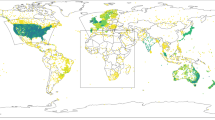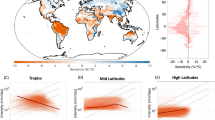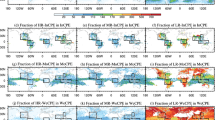Abstract
RAINFALL intensity within clouds may be greatly increased by the production of satellite drops when raindrops collide, and this process could explain the extremely high rates of rainfall development reported in certain clouds1,2. We have set out to test this possibility by laboratory experiments.
This is a preview of subscription content, access via your institution
Access options
Subscribe to this journal
Receive 51 print issues and online access
$199.00 per year
only $3.90 per issue
Buy this article
- Purchase on SpringerLink
- Instant access to full article PDF
Prices may be subject to local taxes which are calculated during checkout
Similar content being viewed by others
References
Moore, C. B., and Vonnegut, B., Physics of Precipitation, Geophys. Monog. No. 5 (Amer. Geophys. Union, Washington, 1960).
Muchnik, V. M., Studies of Clouds, Precipitation and Thunderstorm Electricity, 219 (AMS, Boston, 1965).
Marshall, J. S., and Palmer, W. M., J. Meteorol., 5, 165 (1948).
Author information
Authors and Affiliations
Rights and permissions
About this article
Cite this article
BRAZIER-SMITH, P., JENNINGS, S. & LATHAM, J. Accelerated Rates of Rainfall. Nature 232, 112–113 (1971). https://doi.org/10.1038/232112b0
Received:
Revised:
Issue date:
DOI: https://doi.org/10.1038/232112b0
This article is cited by
-
Thermally induced collision of droplets in an immiscible outer fluid
Scientific Reports (2015)
-
Temperature-Induced Coalescence of Colliding Binary Droplets on Superhydrophobic Surface
Scientific Reports (2014)



